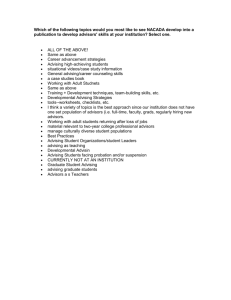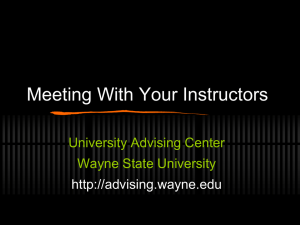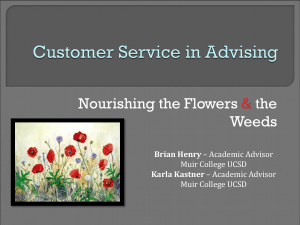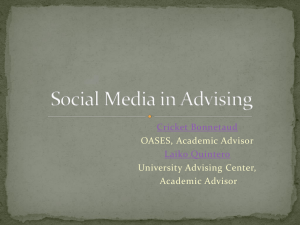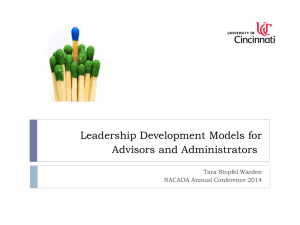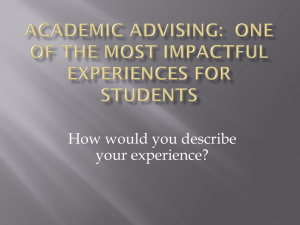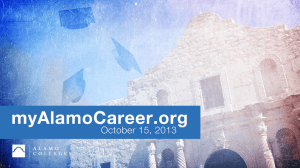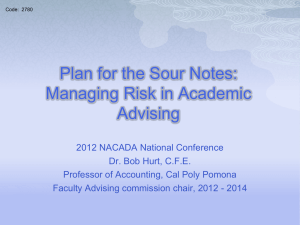Academic Objectives
advertisement
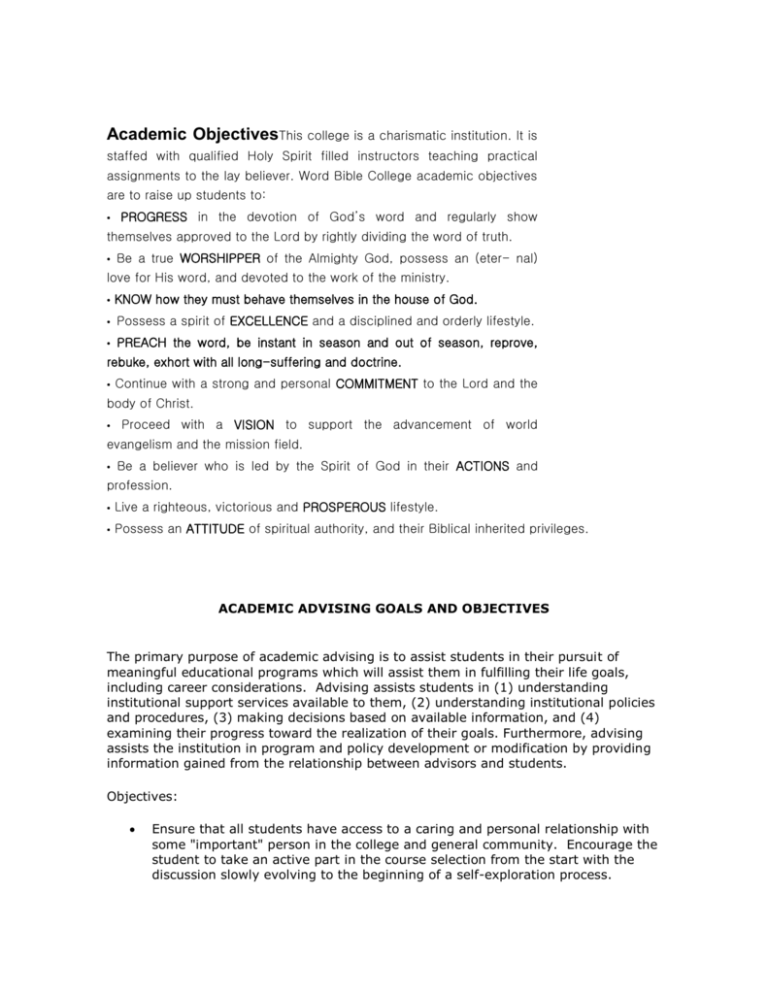
Academic ObjectivesThis college is a charismatic institution. It is staffed with qualified Holy Spirit filled instructors teaching practical assignments to the lay believer. Word Bible College academic objectives are to raise up students to: • PROGRESS in the devotion of God’s word and regularly show themselves approved to the Lord by rightly dividing the word of truth. • Be a true WORSHIPPER of the Almighty God, possess an (eter- nal) love for His word, and devoted to the work of the ministry. • KNOW how they must behave themselves in the house of God. • Possess a spirit of EXCELLENCE and a disciplined and orderly lifestyle. • PREACH the word, be instant in season and out of season, reprove, rebuke, exhort with all long-suffering and doctrine. • Continue with a strong and personal COMMITMENT to the Lord and the body of Christ. • Proceed with a VISION to support the advancement of world evangelism and the mission field. • Be a believer who is led by the Spirit of God in their ACTIONS and profession. • Live a righteous, victorious and PROSPEROUS lifestyle. • Possess an ATTITUDE of spiritual authority, and their Biblical inherited privileges. ACADEMIC ADVISING GOALS AND OBJECTIVES The primary purpose of academic advising is to assist students in their pursuit of meaningful educational programs which will assist them in fulfilling their life goals, including career considerations. Advising assists students in (1) understanding institutional support services available to them, (2) understanding institutional policies and procedures, (3) making decisions based on available information, and (4) examining their progress toward the realization of their goals. Furthermore, advising assists the institution in program and policy development or modification by providing information gained from the relationship between advisors and students. Objectives: Ensure that all students have access to a caring and personal relationship with some "important" person in the college and general community. Encourage the student to take an active part in the course selection from the start with the discussion slowly evolving to the beginning of a self-exploration process. Ensure that all students have access to reliable and valid academic advising services at all times throughout the academic year. Encourage all students to seek advising from their designated advisor at times other than the peek periods of registration or other major administrative programs. Ensure that all academic advisors are providing specific and accurate information. Maximize student awareness of short and long range educational goals. Facilitate successful attainment of students' educational/career goals. Get as many faculty involved in student advising as possible. Minimize the frustration of students and faculty during registration and dropadd periods. Assist in the retention of students in their academic program. Integrate the resources and expertise of professional student services personnel and faculty in the delivery of advising services. Prepare and distribute material to assist advisors in providing correct information to students regarding registration procedures, academic regulations, and graduation requirements. Ensure that all advisors have access to necessary student records. Maintain an on-going, in-service training program for all individuals involved in the delivery of academic advising services. Constructing Learning Objectives for Academic Advising Holly Martin Assistant Dean and Academic Advisor University of Notre Dame Numerous academic advising units are adopting the learning-centered advising paradigm advocated in many recent NACADA Journal essays, including Lowenstein in "If Advising Is Teaching, What Do Advisors Teach?," Hemwall and Trachte in "Academic Advising as Learning: 10 Organizing Principles," and Melander in "Advising as Educating: A Framework for Organizing Advising Systems." When advising units adopt a learning-centered advising philosophy it is extremely helpful to construct specific learning objectives (goals) for advising. The advisors need to know what they are teaching through their interaction with their advisees, and the students need to know what they are supposed to learn through their interaction with an academic advisor. Defining learning objectives Learning objectives answer the question: what should students learn through academic advising? Specifically, what should advisees learn to do as a result of academic advising; what information should they be able to articulate and what skills should they be able to demonstrate? Learning objectives are not the same as a list of advisor/advisee responsibilities. Outlines of advisor/advisee responsibilities are often an important part of clarifying expectations and sometimes have learning objectives embedded in them. However, they are focused on behavior that makes learning possible e.g., attendance at group meetings and prompt communication. Learning objectives are focused on clarifying the intended learning outcomes rather than the behavior that will make those outcomes more likely. The purpose of advising learning objectives It has long been known that developing learning objectives helps classroom instructors achieve better clarity about what they want to accomplish in their classes, and greater clarity about what techniques they need to use to achieve those goals. Specific learning objectives also help students achieve those learning objectives more easily because they know, from the beginning, the goals of the course. Learning objectives give students a way to think about and talk about what they are learning. In addition, specific learning objectives make it possible to more reasonably assess how well the process of teaching and learning is progressing. In this case, what is true for the classroom instructor is also true for the academic advisor. The process of constructing learning objectives helps advisors focus on the question of what students should learn through academic advising and how they are going to teach it. The use of welldesigned learning objectives can help to focus advising sessions and shape advising strategies, as well as help students become more active and self-directed learners in the advising process. In addition, constructing learning objectives can assist in creating a method of assessing the effectiveness of advising practices through clear and attainable goals for advising outcomes. The content of advising learning objectives Learning objectives are generally constructed around three major areas: information, skills, and cognitive development. What information should the student learn through academic advising? What specific terms, rules, procedures, and systems will be taught that the student should be able to clearly state? This information might include the basic requirements of the college and department, how to register for courses, and where to find details and information about options and exceptions. What skills should the student learn through academic advising? What tasks, skills or competencies should he or she be able to demonstrate? These skills might include various kinds of academic planning, communication, technical, and study skills. For example, the student should learn to build an academic schedule that fulfills necessary requirements while it also keeps open options and/or develops special interests. What cognitive or developmental changes should the student be able to demonstrate due to academic advising? How should the student's thinking have changed? This might include the student's ability to articulate the purpose of the requirements and curriculum as well as the advisee's ability to create his or her own academic path within the structure supplied by the college or university. It might also include evidence that the student can intentionally discover and plan for lifelong intellectual interests. Learning objectives that fit the unit's mission and the students' needs Learning objectives need to be tailored to fit the needs of the university, college, or departmental environment in which students function. They also must be shaped to fit the academic advising model in use and, of course, they must be tailored to the needs of the students being advised. Mission statements are extremely useful in constructing learning objectives. Reviewing the university, college, and/or departmental mission statement, as well as the advising unit's own mission statement, helps direct focus on what is being taught and helps identify which skills are being taught in the context of advising. For example, teaching students how to research majors and to recognize their academic skills and interests is a step toward teaching them to be self-directed learners, a common goal at many colleges and universities. Because the creation of learning objectives for academic advising is similar to creating learning objectives for traditional classroom courses, teaching centers designed to assist classroom instructors can be extremely helpful. Personnel in these campus teaching centers can suggest reading material, may have learning objective workshops in place, and can often meet with the advising unit to consult on their particular needs. The academic advisors themselves are the experts on what learning objectives are most important to their own students, many of whom have special tasks they must master. For example, first generation students may need more instruction about the curriculum and the opportunities found at an institution. Student-athletes may need special assistance in learning how to manage their time. Learning objectives chosen by academic advisors will vary depending on the needs of the student population. Often writing an academic advising syllabus is done in tandem with constructing learning objectives, but, even if a formal syllabus is not created, most units have an implied syllabus that can be used to help generate specific learning objectives. At certain times of the academic year, advisors are engaged in different kinds of teaching tasks. First year advisors, for example, begin by teaching students how to build reasonable first semester schedules that support their academic and career goals; next they assist students in making the transition to college-level academics; then advisors help students discover their preferred area of study after they have had a chance to adjust to college more generally. At different times of the year, advisors teach different skills. Identifying the information and skills being taught at each point in the process is a vital step in constructing learning objectives that fit the students' needs. Once the basics of constructing learning objectives are understood, it is useful to develop objectives as an advising unit and to build consensus within the unit. Because advising outcomes are generally judged against learning objectives, it's important that advisors feel that the objectives are attainable and that they know good techniques for teaching them. Having advisors work as a group to draft learning objectives is helpful. Allowing advisors to revise the learning objectives until everyone is reasonably comfortable with them is also recommended. Some practical considerations in constructing and using learning objectives In addition to creating the learning objectives themselves, several other practical considerations are important. Advisors should decide on the order of the learning objectives, how they will be taught, how they will be used in various kinds of advising situations, and how progress towards them will be evaluated. Below are a few suggestions: *Keep the learning objectives reasonable in number. Too many learning objectives will feel overwhelming both to the advisors and to the students. *List the learning objectives sequentially, in students' normal developmental pattern. For example, list those learning objectives that pertain to achieving basic academic competence before focusing on long-range planning. *Academic advisors can use learning objectives to help plan teaching strategies, focused individual and group communications, and meetings. Discussion of learning objectives in advisor staff meetings can also help advising units become more forward-looking in their work with the students. *Include only those learning goals that the advisors can reasonably teach. If you have no strategies for teaching advisees to be better world citizens, don't list it as a learning objective. *Try to have several concrete teaching strategies for each objective. For example, students might learn about the department requirements through your email communication with them over the summer, through a handout you review with them in a one-on-one meeting early in the semester, and through the completion of a form they hand in to you before registration. *It's useful for the students to know from the beginning what the academic advising learning objectives are and how their advising experience will be different from what they experienced in high school. Therefore, distributing and discussing advising learning objectives in orientation sessions and/or through early communications with students is extremely helpful. *Students also find it helpful if advisors return to the learning objectives at various points in the semester, discussing them in one-on-one meetings as well as in group meetings and communications. This assists students in judging their progress towards meeting those objectives and in understanding how the advisors will assist them in achieving those learning goals. *Because advisors and students should assess progress toward learning goals, make certain learning goals are stated in such a way that the achievement of the goal is easily demonstrated. For example if one of the learning objectives is "By midterm of their first semester, students should be able to use the institution's computer-based communication system to stay informed of academic deadlines/opportunities and communicate with advisors and other faculty members," it is reasonably easy to construct various means of determining the students' competence in these areas. *Learning objectives should be dynamic. They should be flexible and change with the changing character of the student body, faculty, and institution. Plan on reviewing and rewriting them with some regularity.
